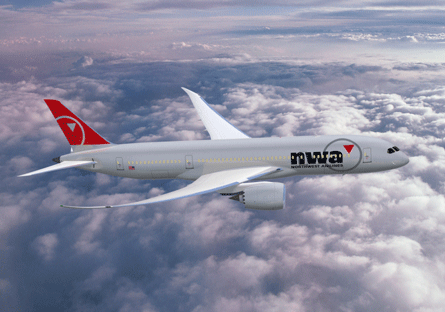Boeing has delayed final assembly for the first 787 by five months, extended the flight-test period by one month and yet preserved its two-year and long-term production ramp mostly intact.
With first flight delayed from August to the first quarter of 2008, delivery to 15 of the 787's 48 customers and assembly of 30 to 35 aircraft will shift from mid-2008 to end-year or early 2009, says Scott Carson, president of Boeing Commercial Airplanes.
 |
|---|
© BoeingNorthwest Airlines, the North American launch customer for the 787, may not receive the twinjet until 2009 |
Despite announcing the second replan for the programme in as many months, Boeing is confident the assembly crisis is largely contained to the first aircraft. It is the sheer amount of reassembly tasks for that aircraft - and no longer shortages of fasteners and software - driving the delay, Carson says.
"We have much more confidence in our ability to achieve this plan," he says.
Two-year production will amount to 109 aircraft by 2009 and escalate to 10 aircraft a month in 2010 and perhaps rise higher after 2011. Boeing suppliers previously reported studies to eventually raise monthly production rates to between 14 and 16 aircraft.
Boeing, however, acknowledges the six-month delay does not remove all risk. Adding four weeks of flight test improves on Boeing's first replan, but still falls at least one month short of the original schedule to complete airworthiness certification in eight months.
Secondly, as many as 35 aircraft instead of 22 will be produced during the flight-test phase, potentially causing more delays if design changes are necessary.
Although the Honeywell flight-control software is no longer driving the delay, the system remains behind schedule. Originally due to be complete in mid-August, Boeing has installed only an "interim" software load in aircraft one and is continuing to work out the bugs.
Fastener inventories may no longer be in crisis, but Boeing and suppliers agree that the issue will continue to need careful management into the future.
Boeing's original schedule called for a first flight in late August and first delivery to All Nippon Airways in mid-May 2008. On 5 September, Boeing delayed first flight to mid-November to mid-December, but kept the delivery schedule to ANA intact.
The most recent plan means first flight will be delayed up to seven months, while first delivery is delayed at least six months.
The decision to announce the new delay came after an internal update meeting on 8 or 9 October, says Boeing chief executive Jim McNerney.
Boeing executives also noted making small steps of progress. The first flight-test aircraft has been removed from its jacks and is resting on its own landing gear.
Boeing also plans to keep the other major development programmes, such as the 747-8, 777F and other 787 variants, on schedule, even as engineering resources are shifted to meet the immediate crisis.
Source: Flight International























